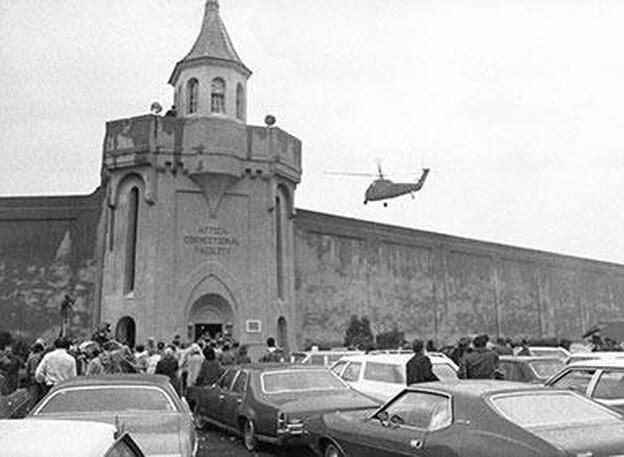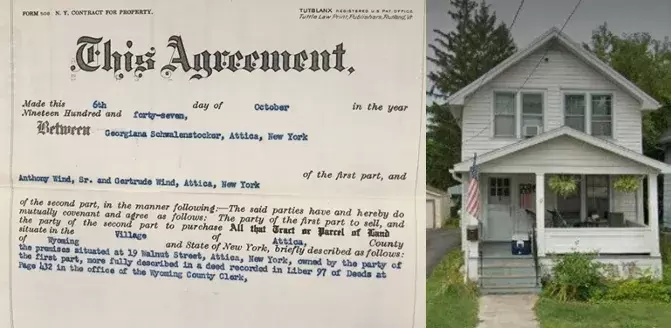|
The legacy of the Attica prison uprising A branch of my family has lived in Attica, NY, for 80 years. Less than a mile from the small, bucolic upstate town is the maximum-security prison that’s (in)famous for an uprising where 32 prisoners and 11 hostages were killed during the violent retaking in September 1971. My maternal great-grandfather was a plumbing instructor at the prison in the late 1940s, after moving to Attica when he retired. My mother and her siblings remember that the town had an ice cream store and a movie theater and that their grandparents’ house—at 19 Walnut Street—had an outdoor pump with refreshing icy cold water. She remembers that her dad avoided driving past the prison on the way in to town. The deed for the Attica house for which my maternal grandparents paid $7,000 in 1947, and the house today. Given this personal history, I was interested to read Blood in the Water: The Attica Prison Uprising of 1971 and Its Legacy, a 2016 Pulitzer-prize winning book on the prison uprising by Heather Ann Thompson. Growing up, I remember hearing the event referred to as a “riot,” so I found the difference in terminology particularly interesting. The uprising stemmed from the inhumane conditions at the prison, which was overcrowded with mostly Black and Puerto Rican prisoners, some of whom were incarcerated for issues as minor as breaking parole after a teenage joy ride. Others were hardened criminals and/or inmates who had participated in earlier uprisings in other prisons. The inmates suffered from inadequate and poor food, minimal exercise, frequent isolation, brutal and indifferent doctors, and daily mistreatment by racist corrections officers, just to name a few grievances. During the hot summer of 1971, the commissioner of prisons failed for months to respond to the inmate’s letter asking him to address conditions, and after an incident where two inmates “disappeared” following an altercation with guards, tensions were high. When some of the inmates realized they were trapped in a tunnel leaving the mess hall and were not going to the yard for exercise as was usual, and faced with the head guard responsible for the disappearances, they panicked, fatally injuring a guard and taking 42 staff hostages. The inmates immediately elected a diverse group of leaders, established a security detail for the hostages, enforced their own rules, and stocked and staffed a medical station. They then asked for the prison authorities to bring in a group of outside negotiators. During three days of negotiations, the authorities agreed to meet many of the prisoner’s demands for better treatment. They also laid plans to retake the prison by an overwhelming force, arming NYS troopers with weapons outlawed by the Geneva Conventions and (illegally) failing to track who was receiving them. When Governor Nelson Rockefeller gave the OK, officials blasted the inmates and hostages with immobilizing tear gas and followed it up with a barrage of bullets. Ill-prepared state troopers and guards killed 10 of the hostages and 32 prisoners.
Coverups, deliberate sabotage of the many investigations into the uprising, and threatening of coroners and undertakers began immediately. “Repeat a lie often enough and it becomes the truth,” is an idea attributed to Hitler’s propaganda minister, Joseph Goebbels. During the uprising, officials immediately began feeding lies to the journalists covering the event. They made up stories about prisoner abuse of hostages and claimed these were new types of dangerous “radical, militant prisoners.” In truth, the inmates had gone out of their way to protect the hostages, providing mattresses and blankets, medical care and food. In a few cases, the inmates literally took bullets for them during the retaking. None of the hostages were killed by prisoners. Buffalo Evening News headlines on September 13, 1971. “Rocky,” Governor Nelson Rockefeller, blamed the inmates for the bloodshed he authorized after refusing to talk to the prisoners about problems at the prison. Decades-long lawsuits recounted the horrors inmates suffered at the hands of vengeful corrections officers, both in the immediate aftermath of the retaking, when they were beaten and denied care for their wounds, and in the ensuing months when they were subjected to physical and mental torture.
But, although reporters tried to walk back the horror stories when the truth came out, it was too late. Attica was used to justify some prison reforms (many short-lived), but also a massive backlash that resulted in harsh “tough on crime” laws and punishments that directly led to our current overcrowded conditions and the disproportionate incarceration of Black and brown men. And Attica itself is now worse than ever.
0 Comments
Leave a Reply. |
AuthorHeidi Hackford explores how past and present intersect. Archives
November 2023
Categories |


